There is no better country in the world for eating. Malaysia has such an interesting mix of cultures which comes out in their food for some truly beautiful eating options!
The cuisines in Malaysia are those of its three main cultural groups – Malay, Chinese and Indian – but it’s also a fusion and adaption of these foods to suit the local environment. Add in colonial influences and Thailand and Indonesia right next door, and there is a huge range of food and flavours in Malaysia traditional food.
I absolutely love eating in Malaysia. It’s easy to find something I want to eat and for great prices too. Of course, when you first come to Malaysia, it can be a little overwhelming.
The dish names can all be unfamiliar, so it can be hard to know what you’ll get when you’re ordering local food in Malaysia. But you don’t need to worry because no matter what Malaysia food items you order, it’s probably going to be good.

While you can always just point at what other people are eating that looks good, you’ll have a much tastier experience in Malaysia if you understand what the local Malaysian food is. This way you can order the dishes that most appeal to your palate.
Below, I help you with this! Consider this article about Malaysian traditional food to be your food bible when travelling in Malaysia. Bookmark it and keep coming back so you’ll always know what you can order. You’ll be able to find items on this list of most famous Malaysian food in the majority of restaurants.
I also discuss some of Malaysia’s most popular drinks and the places where you can eat in Malaysia and much more.
By the end of this article, you’ll feel completely comfortable about ordering and eating traditional food in Malaysia which will lead to the most delicious trip possible! This is the best Malaysian food blog for discovering everything there is to know about the most popular Malaysian food.
Travelling to Malaysia? Click here to download your free Malaysia Trip Planning checklist. We’ll help you get ready for your trip!
Have any questions? Join our Malaysia Travel Planning Facebook group here now! It’s the perfect place to ask any questions and to be inspired.
Contents
What Is The Traditional Food Of Malaysia?
The traditional food Malaysia offers is a blend of the different cultures that have left their mark on the country. The most famous food in Malaysia has been shaped by the Chinese, Indian, Malay and European influences that have existed here.
Malaysian local food is characterised by the variety of herbs, spices and ingredients that make the dishes flavourful, aromatic and colourful. Ingredients like coconut milk, chilli, tamarind and lemongrass provide the famous Malaysia food with their unique flavor and aroma.
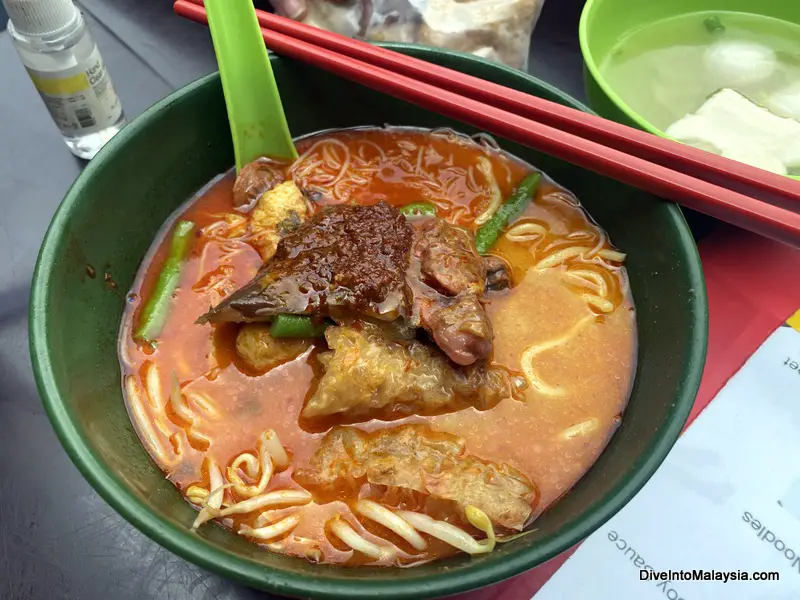
The food is typically prepared using cooking techniques such as stir-frying, grilling, boiling and steaming. Rice is very common and often served with meals.
Typical Malaysian food is known for its rich and diverse flavors. The most popular food in Malaysia is often a combination of sweet, sour and spicy (but note that it is not hard to avoid spicy Malaysian food if that’s your preference).
The use of fresh ingredients is also an essential aspect of the country’s food culture. Malaysians are serious about their food and the best food in Malaysia will use fresh ingredients.
If you are wondering is Malaysian food healthy, it commonly is. The fresh ingredients and spices lead to healthy Malaysian food. In fact, I eat far more vegetables in Malaysia than I do at home simply because they are prepared so well with other flavours which make them delicious.
Malaysia is proud of its food and cuisines and it’s very easy to have delicious Malaysian food experiences.
Types Of Malaysian Food
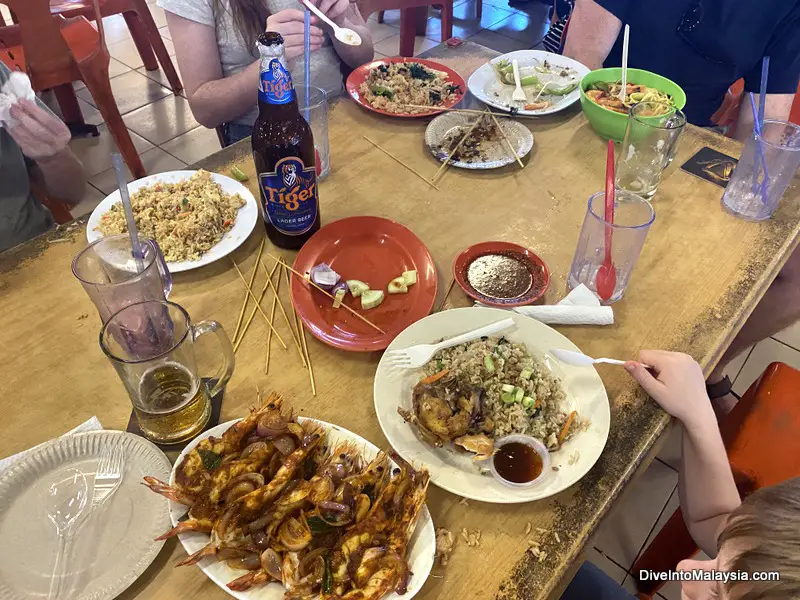
Here’s a list of the main cuisines you’ll find in Malaysia.
- Malay Cuisine – This is the traditional food of the Malay community in Malaysia. It is characterised by the use of herbs, spices and coconut milk. Some popular Malay dishes include nasi lemak, rendang and satay.
- Chinese Cuisine – This is the traditional food of the Chinese community in Malaysia. It is characterised by the use of ingredients such as soy sauce, ginger and garlic. Some popular Chinese dishes include hokkien mee and char kuey teow.
- Indian Cuisine – This is the traditional food of the Indian community in Malaysia. It is characterised by the use of spices such as cumin, coriander and turmeric. Some popular Indian dishes include roti canai, tandoori chicken and biryani.
- Peranakan Cuisine – This is the traditional food of the Peranakan community in Malaysia. It is a fusion of Malay and Chinese influences. Some popular Peranakan dishes include laksa, otak-otak and ayam buah keluak.
- Western Cuisine – Western food has become increasingly popular in Malaysia in recent years. Some popular Western dishes include burgers, pizzas and pastas.
There is a fabulous street food culture in Malaysia and you can get some very cheap Malaysian food this way that’s also very good. This can come from any of the above cuisines with dishes such as mee goreng, nasi goreng and nasi kandar being very popular.
Halal Malaysian Food

About 63% of Malaysians follow Islam so there is plenty of Malaysian Halal food.
Halal simply means lawful or permitted in Arabic and generally means what is allowed under Islamic law. Halal food simply means that it has been prepared in accordance with Islamic dietary laws.
When it comes to meat, the animals must be slaughtered in a certain way for it to be considered Halal. Additionally, the meat from many animals is considered not Halal no matter how it is slaughtered. The main one of note is pork, so you will not find pork products in a Halal (or Malay) restaurant.
Vegan food is generally always allowed. With dairy and eggs, there are some rules, although these vary depending on how Islamic law is interpreted.
Alcohol is also strictly prohibited. Any food that has been prepared with food that aren’t Halal is also prohibited.
This is a very simplified and generalised definition of Halal food.
It does affect food in Malaysia in general. Like, you probably won’t find bacon or any pork products in your breakfast buffet at your hotel. There is a general lack of alcohol around compared to many other countries. If you want a beer with your dinner, your best option is to try a Chinese restaurant.
Vegan And Vegetarian Malaysian Food
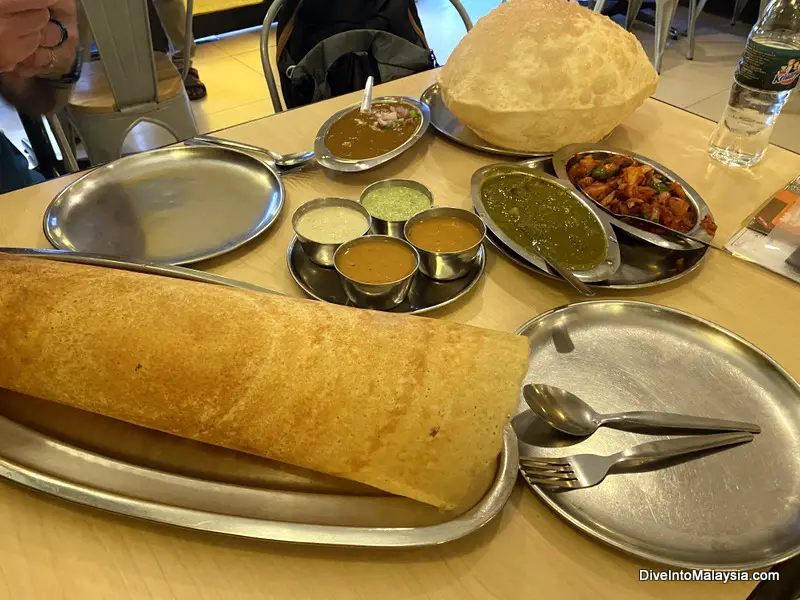
I was vegetarian when I lived in Malaysia and I never found it a problem at all. There are plenty of vegeterian options… HOWEVER, if you are very strict about it, it can be tricky. I ignored the fact that fish sauces are often used in dishes and meat had probably been prepared in the same dishes and pans.
If you are looking for Malaysian vegan food, it can be trickier again as eggs are often used. The upside is that dairy in food is not common.
If you want to be sure you avoid any meat or animal products, Indian restaurants are your best bet so head to the closest Little India. Many Hindus are vegetarian so you are more likely to find this option among this cuisine.
There are more and more vegetarian and vegan restaurants opening up in Malaysia.
What Is Malaysian Food Like?
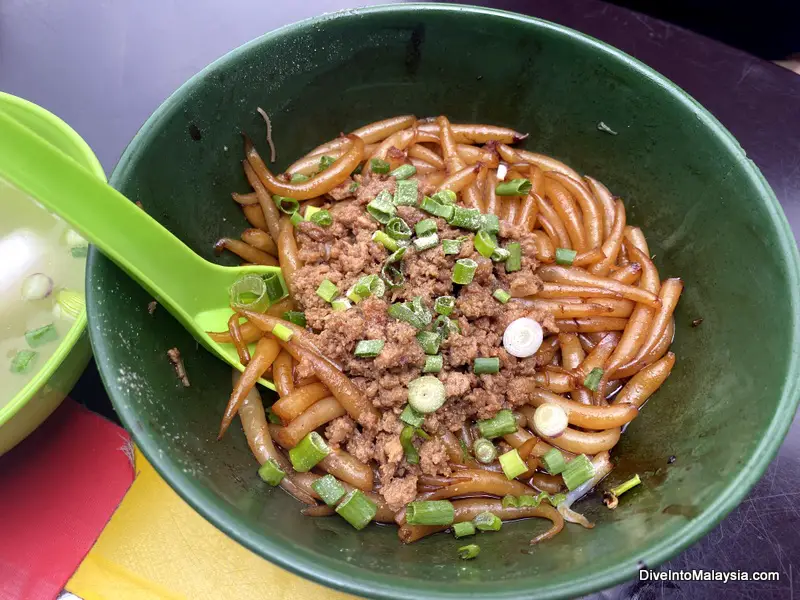
Like stated previously, Malaysian food is a blend of different cultural influences including Malay, Chinese, Indian and Peranakan. This leads to a diverse cuisine with its own unique blend of flavours, spices and textures. It’s also an inclusive cuisine catering to many different dietary requirements thanks to the religions and preferences of its people.
The famous food of Malaysia is known for its bold flavours and tastes. There can be so many different options, flavours and experiences that it is somewhat hard to generalise about food traditional in Malaysia.
You can have nasi lemak which is a fragrant rice dish cooked in coconut milk and served with anchovies, peanuts and a spicy chilli paste. Or try satay which is grilled meat skewers served with a peanut dipping sauce. Or a delicious laksa which is a spicy noodle soup.
And don’t forget rendang which is a slow-cooked meat dish with a rich and spicy sauce.
Why Malaysian Food Is The Best

I may be completely biased, but authentic Malaysian food is the best in the world 🙂 I love Malaysian food.
I love Chinese, Indian and Malay cuisines all individually and when you bring them together in Malaysia, magic truly seems to happen. It’s also so much fun eating in Malaysia from the hawker centres to restaurants in shopping centres, there’s always something new to try and experience.
Malaysians themselves love good food and take pride in producing delicious food in Malaysia. This vibrant food culture is also part of what makes Malaysian food so brilliant. It’s always striving to be amazing.
It’s accessible, it’s diverse, it’s inclusive and it’s generally quite healthy. Add in the fact that it’s very affordable and I can’t think of a country in the world that is such a great place to eat.
Not convinced? Go to Malaysia. Eat everything in sight. See if you don’t feel the same 🙂
What Food Is Malaysia Famous For?
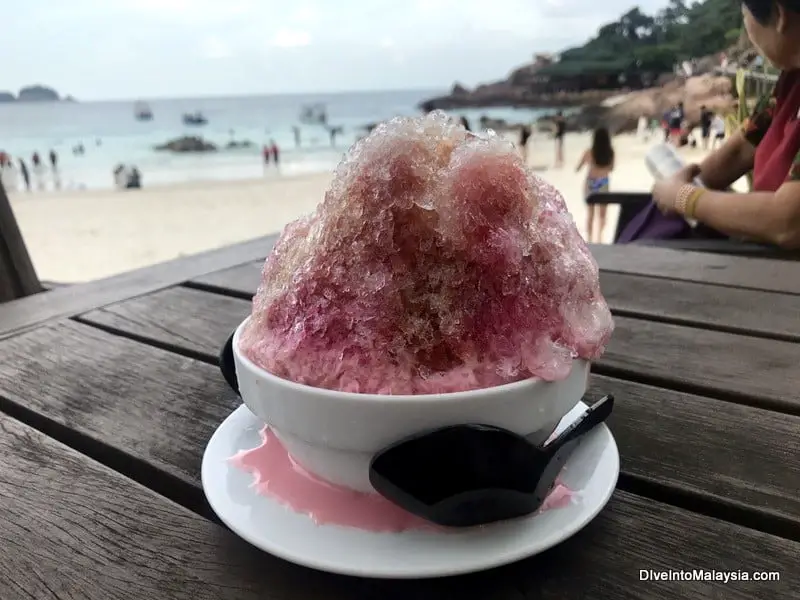
Malaysian famous food includes mee goreng (fried noodles), nasi goreng (fried rice), nasi lemak, laksa, rendang, char kuey teow, roti canai, ice kacang and so much more.
Below, there is our full Malaysian food list of Malaysia most famous food. Read through it, absorb it, bookmark this and come back to it when you’re visiting Malaysia for your top Malaysian food choices.
If you are used to eating Malaysian, Indian or Chinese food at home, you’ve probably come across some of these dishes before.
Want Help Having An Awesome Food Experience in KL?
Join a Simply Enak (aka delicious) Food Tour!
There are three different options depending on whether you want to concentrate on street food, nightlife or off the beaten track places.
No matter what you pick, you’ll taste a range of fabulous local food and drinks while learning the history and culture of Kuala Lumpur.
There’s no better way to discover this great city.
Make sure you use the coupon code DIVE30 for RM30 off your tour.
Some Useful Malaysian Food Names
Here are some useful words which will help you decode names of Malaysian food. While english is widely spoken in Malaysia, menus are often in Malay and knowing some of the main words of Malaysia local food is very helpful.
At the very least, you’ll know if you’re ordering rice or noodles 🙂
- Nasi – rice
- Ayam – chicken
- Ikan – fish
- Sayur – vegetables
- Kari – curry
- Mee – noodles
- Tomat – tomato
- Telur – egg
- Udang – prawns/shrimp
- Sambal – chilli paste/sauce
- Kentang – potato
- Roti – bread
- Daging – meat
- Sup – soup
- Pisang – banana
- Buah-buahan – fruits
- Kacang – beans/peanuts
- Nenas – pineapple
- Kerang – clams/mussels
- Ketupat – rice cake
- Goreng – fried
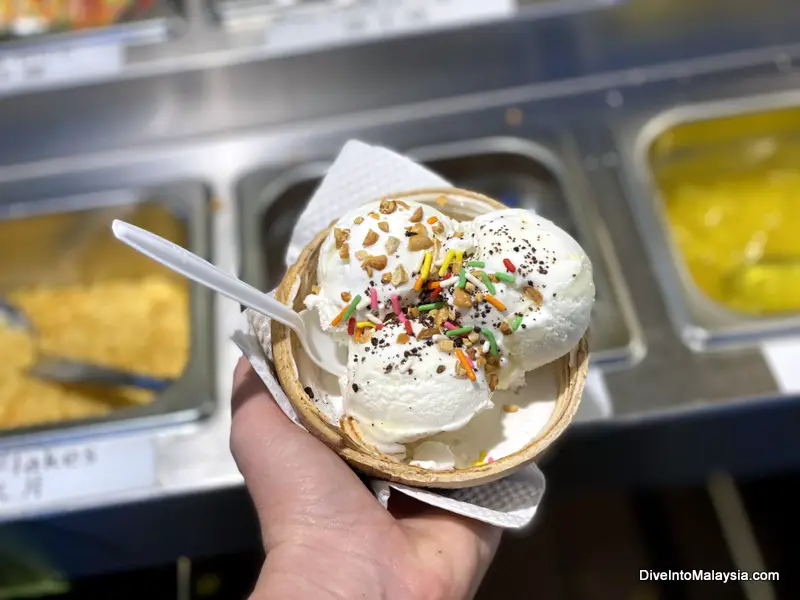
Top 21 Most Famous Malaysian Food (Malaysian Food Pictures And Names
Here is our top list of Malaysian food. See how many of these dishes you can try on your trip! There are also plenty of images of Malaysian food in this list so you can get a better idea of what you can expect.
However, note that these dishes can vary based on where you go. For example, I have had countless mee gorengs over the years. Yet, they can taste and look quite different. So you may find the Malaysia famous food that you order looks a little different to what is shown below.
If you are wondering, is Malaysian food spicy?, the answer is sometimes. I have tried to note below when the dish may be spicy. However, these things are not always consistent. It can definitely be tricky at times when my kids were little and randomly, a dish would be spicy when it hadn’t been before.
Generally, I don’t find the food to be that spicy (although I am someone who loves Malaysian spicy food so I may not be as sensitive to it as someone who can’t stand spice). But there are often mild amounts of spice in the food.
If you are troubled by spice, it’s best to ask. However, restaurant workers aren’t always able to communicate that well in English so sometimes you have to cross your fingers 😀 Overall, you definitely won’t go hungry if you hate spice though so don’t worry.
Roti Canai

Roti canai is a popular dish which is considered a Malaysian national food. It definitely should be on your list of must try Malaysian food. It’s most often eaten for breakfast but it can be a snack throughout the day.
It originates from southern India. The roti is a textured flatbread made from ghee and flour. It’s fun to watch them make it if you get the chance – which is usually not hard to find. You can watch the chef prepare the dough by kneading, flattening, oiling and folding it. It’s tossed around until its paper thin and cooked in a frying pan.
The best roti will be flaky on the outside and smooth in the inside. I have found roti to be so much more delicious in Malaysia than at home in Australia in an Indian restaurant. It’s not comparable.
Roti canai is this roti served with a side curry dip. This side can vary from dahl curry to a more sambal tasting curry to a very liquid curry and it can be spicy. Since it’s a side, you can eat as much or as little of it as you want.
Outside of Malaysia, we’ll eat this as a starter at Malaysian restaurants. In Malaysia, we love it for breakfast.
While I definitely recommend you try to buy this from a roti vendor or local restaurant, it’s also often available at hotel breakfast buffets so you really have no excuse not to give it a go 🙂
Nasi Lemak
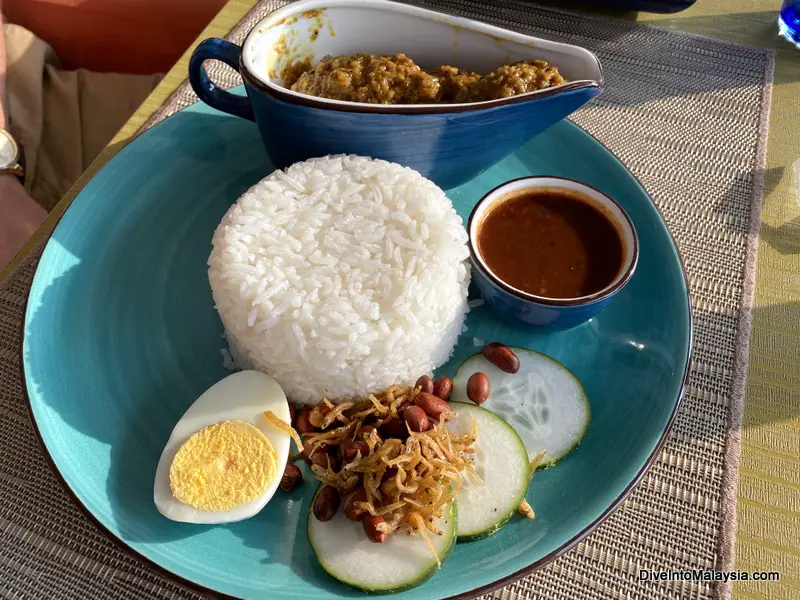
If there was only allowed to be one national food of Malaysia, I feel it would be nasi lemak! Malaysian food is epitomised in this dish.
Translated directly, it means fat rice! It’s a dish of coconut rice and usually sambal, fried anchovies, peanuts, cucumber, boiled egg and (often) rendang, although this can vary a little.
When you first have it, nasi lemak can feel like a strange dish of random things served with rice. However, I promise you that it won’t seem so random once you try it. Everything is there for a reason and the combination of flavours is delicious.
Everything is usually served around the rice so you can mix it as you see fit. It also means this dish still works even if you don’t like one of the ingredients.
Like roti canai, nasi lemak is usually eaten at breakfast, although you can have it at any time of day. It’s also often available in hotel buffets where you can make it yourself with the ingredients you like best.
What I like about nasi lemak as well is that you generally know what you’re going to get. While the sambal and rendang parts can vary, these are only small parts of the dish so I know I will like at least most of it and won’t get a total surprise when I order it. For this reason, I usually order nasi lemak on flights when I want to be sure I’ll enjoy my meal. It’s rare it’s not an option.
Satay
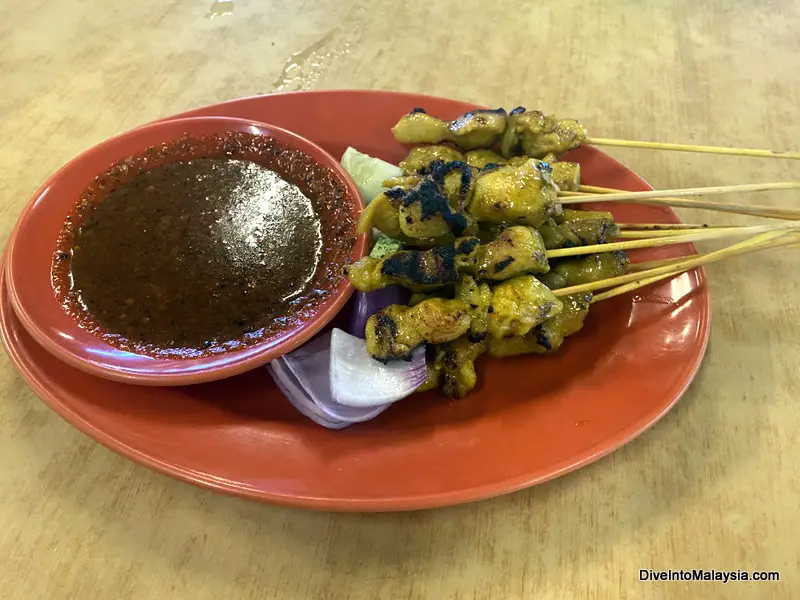
Also considered a Malaysia national food, you won’t want to miss eating some authentic Malaysian food Satay. Originating in Indonesia, Malaysia has made this dish its own.
Satay is basically meat kebabs – so meat on sticks – seasoned and grilled over charcoal. Many different meats can be used, and you usually specify which one you want. It can also be prawns, vegetables or tofu, but most commonly, it’s chicken.
The seasoning can vary, but it’s always delicious. This can also be the delicious peanut sauce known as satay in countries like Australia.
We found this a great standard dish when our kids were younger and they wanted simpler flavours. We have not had one that is spicy.
It’s a common option in hawker centres and night markets.
Mee Goreng
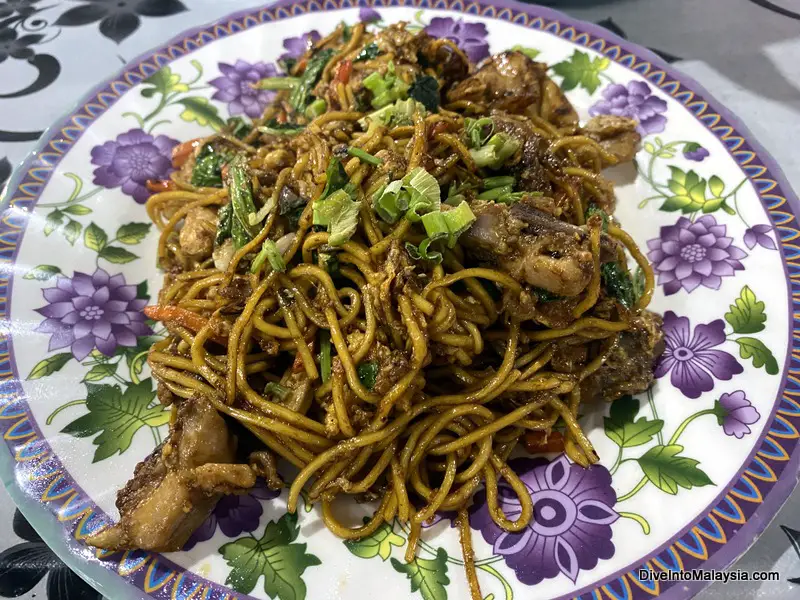
Mee goreng is one of my favourite meals in the world and is a standard Malay dish. I never know exactly how it will taste, but I’ve never had a bad experience. It’s believed to have been derived from chow mein which came to Malaysia with Chinese immigrants. Today, it’s a dish that’s a fusion of Malaysian cultures.
While the name simply means fried noodles, there’s a lot more than this in this dish.
It’s usually made with yellow egg noodles (from Chinese food), spices (from Indian food) and sweetness added for Malay tastes. It usually has a small amount of vegetables and you can pick meat to add (or go without). It’s quite common to have some shrimp in this as well. It’s a very popular Malaysia best food.
I will say with this item that the quality can vary a lot depending on how much you pay. You can easily get mee goreng for super cheap and the Malaysian food cost will only be a few ringgit.
HOWEVER, this does affect the quality with usually less vegetables and meat added which can make the dish a bit plain and boring. However, if you want to save money, this dish can help you do it.
It’s usually only mildly spicy.
Nasi Goreng
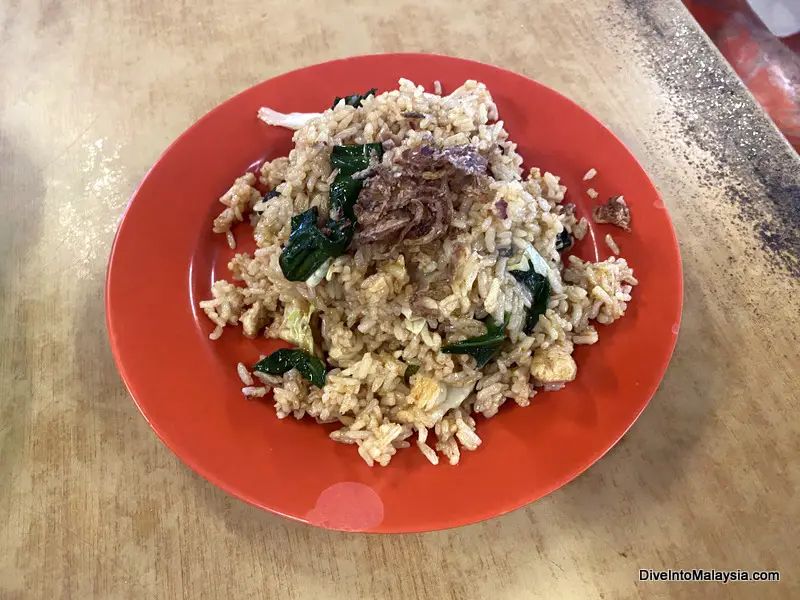
Nasi goreng means fried rice, and it is somewhat the rice equivalent of mee goreng.
It’s usually rice stir-fried with garlic, chilli, lime, fried egg, sometimes tamarind and usually some chicken or prawns.
It’s often eaten for breakfast but you can have it any time of day.
Usually, this dish is not spicy and it was another go-to item for our kids when they were young.
Laksa

There are various types of laksa, but the main one is curry laksa (known as curry mee in Penang).
This is also considered a national dish and deserves to be in any Malaysia top 10 food list. It’s from the Peranakan culture.
It’s basically a noodle soup cooked with thick noodles or rice vermicelli. The soup is rich and spicy with curry flavours, coconut milk and other ingredients like garlic, shallots and lemongrass. Items like tofu, meat, hard-boiled eggs, shrimp and bean sprouts may be added.
It can sound a bit strange (like many Malaysian staple food options can!), but it works together beautifully to create a thick, rich and creamy sauce-and-noodle experience.
In Penang, there is a specialty laksa, asam laksa, which should also be on your list of food to try in Malaysia. Asam laksa is heavy in tamarind (which is what asam means) and has flakey fish. It’s generally quite spicy and sour and is a different taste sensation to a curry laksa as described above.
Rendang
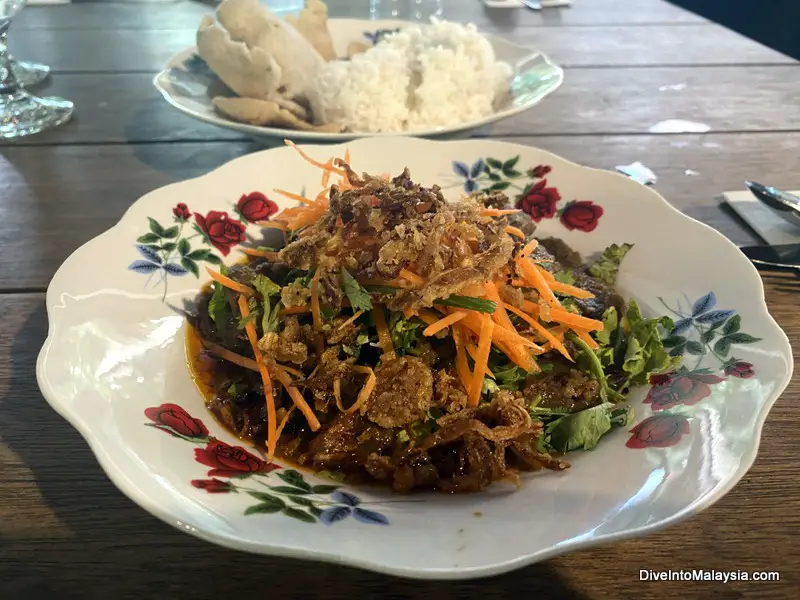
Another Malaysian culture food that is quite famous, rendang is a traditional meat dish that originated in Sumatra in Indonesia and is believed to have been influenced by north Indian curries.
Meat (usually beef) is slowly cooked for hours in coconut milk and spices like turmeric, ginger, chilli, lemongrass and more. It’s ready when the meat is very tender and the liquid evaporates.
It started as a ceremonial dish for special occasions like Eid and weddings, but today, it is eaten at any time.
It’s one of my favourite Malaysia food. The spice level can vary dramatically so be careful if you hate spicy food.
Ikan Bakar
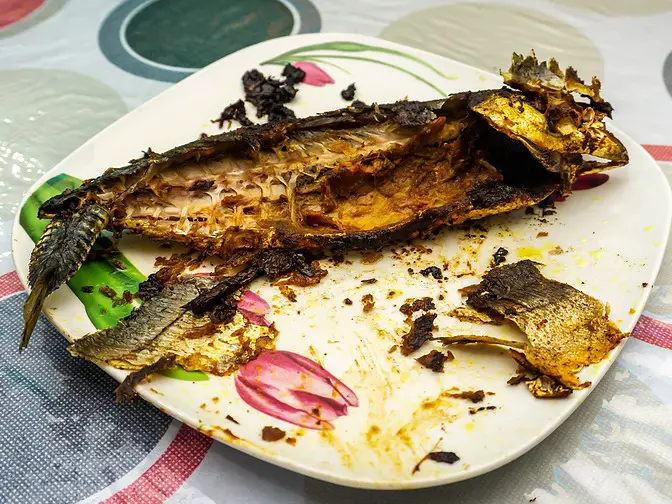
Translating to burned fish (don’t let this turn you off!), ikan bakar can refer to various kinds of grilled fish. In fact, most kinds of fish and seafood (including squid and shrimp) can be made into this dish.
It’s basically fish that has been seasoned with a sambal, turmeric and chilli marinade and wrapped in a banana leaf so it doesn’t break. It’s then grilled over charcoal.
This dish is also popular in Indonesia, but the spices used differ between the nations. In Malaysia, there tends to be more use of chilli and turmeric leading to a spicier and more yellow-coloured dish. This can be spicy.
Sambal Udang
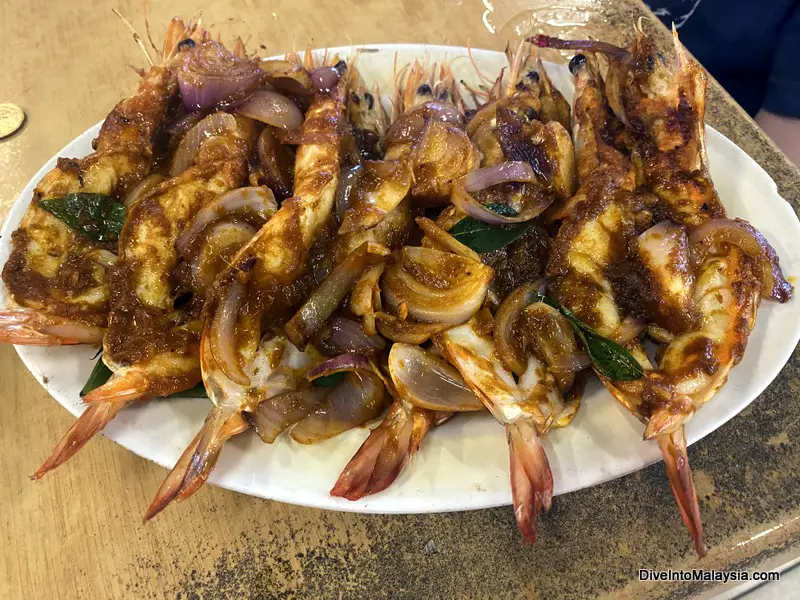
If you love chilli and prawns, this is the best Malaysian street food for you!
This is a Peranakan dish that includes a sambal, so chilli paste, that’s also mixed with prawn paste and tamarind juice. It’s quite tangy and spicy.
The prawns are then simmered in this sauce.
This is a dish I absolutely love. I do find it a little rich though, so I think it’s best to have this when you have someone to share it with.
Ketupat
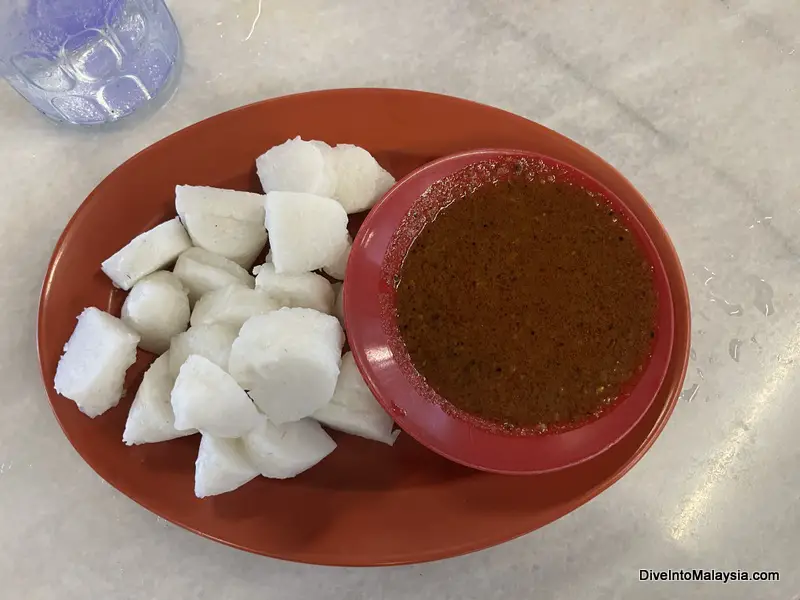
Another local food Malaysia to try is ketupat. It’s basically a rice dumpling and is a side dish rather than a main meal.
Palm leaves are woven together to form a little pouch. Rice is packed inside and then cooked. As it cooks, the rice expands creating a little bundle of rice that you can dip into your curry or other dish.
I find it fun to eat, and the kids enjoy it too. It adds a bit of a novelty to eating so give it a go 🙂
Mee Rebus
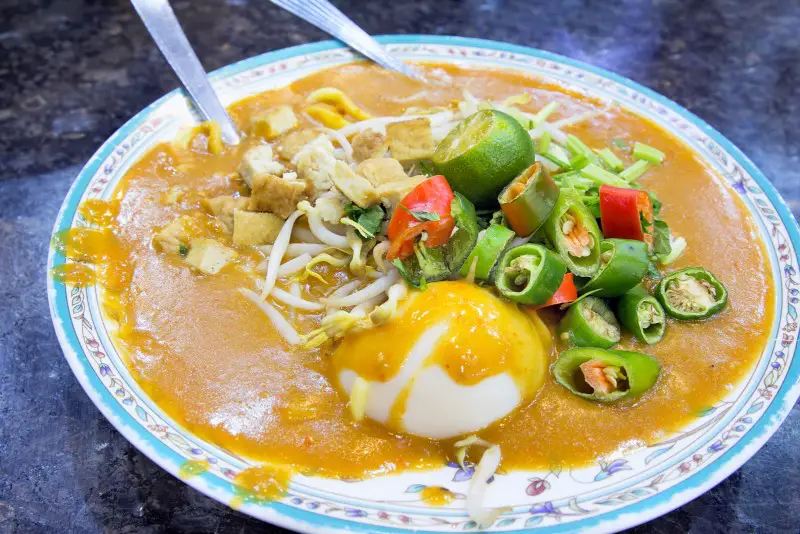
For a mee goreng with a twist, try a mee rebus! It’s a noodle soup dish that originates in Indonesia
It’s made from yellow noodles with a potato, curry-like gravy with lemongrass, ginger and other spices and has a spicy and mildly sweet taste. It can also have tomato as a base ingredient in the sauce.
Many ingredients can be added like shrimp, mutton, anchovies, tanchu (fermented yellow soybeans), shallots, lime and boiled eggs.
Chicken Curry Kapitan
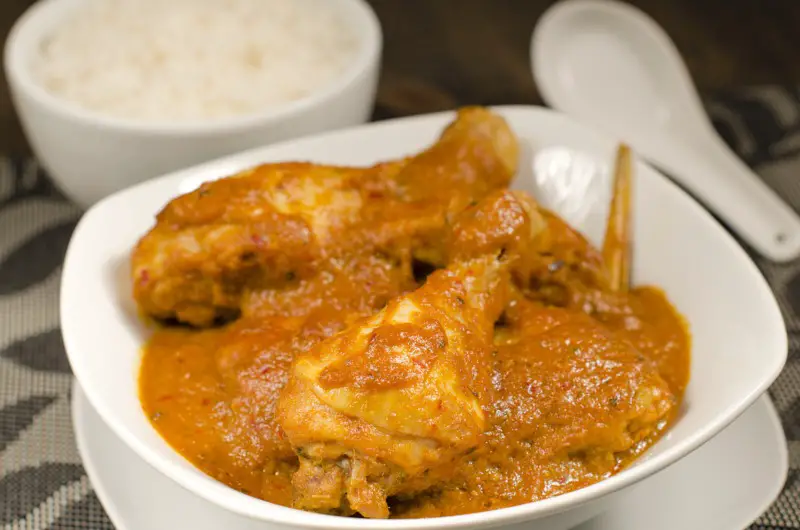
This curry dish has a story associated with the name. Kapitan was the title of Chinese or Indian leaders in Penang. The story goes that a Kapitan asked his chef what was for dinner and the reply was “chicken curry, Kapitan!”. It became this dish.
It’s a Peranakan dish which has quite a tangy flavour thanks to the ingredients of tamarind juice, shrimp paste and turmeric root.
Hokkien Mee
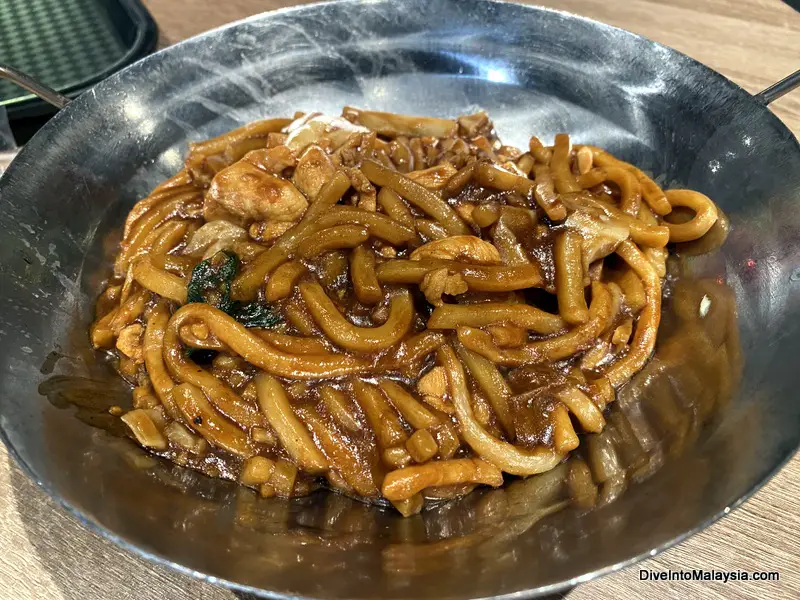
Hokkien mee is popular in Malaysia, Singapore and Indonesia with different places having their own variation.
Kuala Lumpur hokkien mee (also called hokkien char mee) is a stir-fried dish with thick egg and rice noodles and a thick dark sauce. It also can be garnished with prawns, chicken, pork, pork ribs, spring onion and more.
Penang hokkien mee (often called hokkien prawn mee outside of Penang) is a noodle soup dish with egg noodles and rice vermicelli. The rich broth is flavoured with shrimp stock and can include prawns, hard boiled eggs, bean sprouts and sambal.
Char Kuey Teow
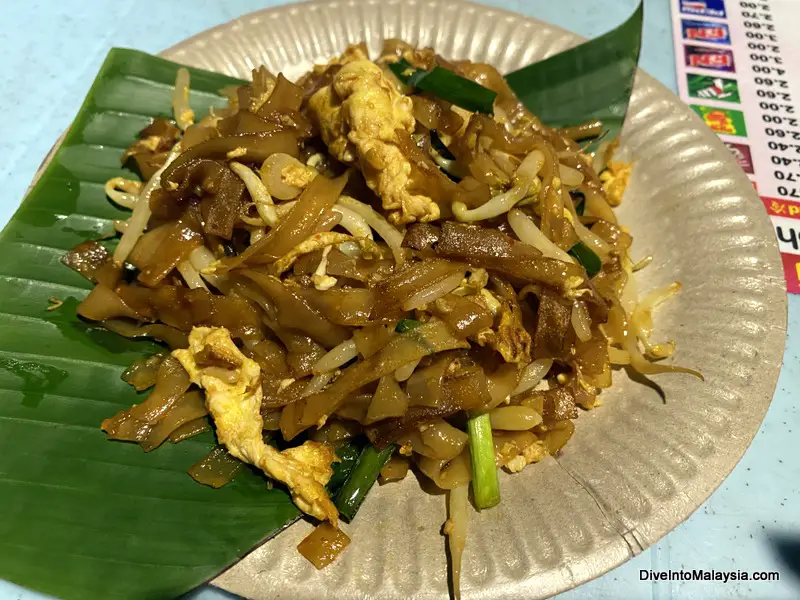
Definitely one of the top 10 Malaysian food that is most famous, char kuey teow is a Chinese noodle dish from Penang.
Made with flat rice noodles, they are stir-fried in pork fat, soy sauce, chilli, cockles, bean sprouts and more. Often prawn in included and it’s possible to get Halal versions.
High heat is used, and it’s best eaten at one of Penang’s street food stalls.
Char Hor Fun

Char hor fun (also called wat tan hor) has many varieties. The most popular in Malaysia is in Penang where it’s all about moist, fat noodles in a gravy-like sauce.
It’s generally cooked with pork, prawns, vermicelli and some greens, but it can also include shredded chicken and egg. Chillies or sambal can be served on the side.
This is one of my favourite noodle dishes as I love how moist it can be.
Hainanese Chicken Rice

Not surprisingly, this dish originated in Hainan, China. Of course, it had been modified for Malaysian tastes. It’s basically chicken and rice boiled in stock with the chicken served on top of the rice.
There is often a side sauce of ginger, garlic and chilli.
Nasi Kandar
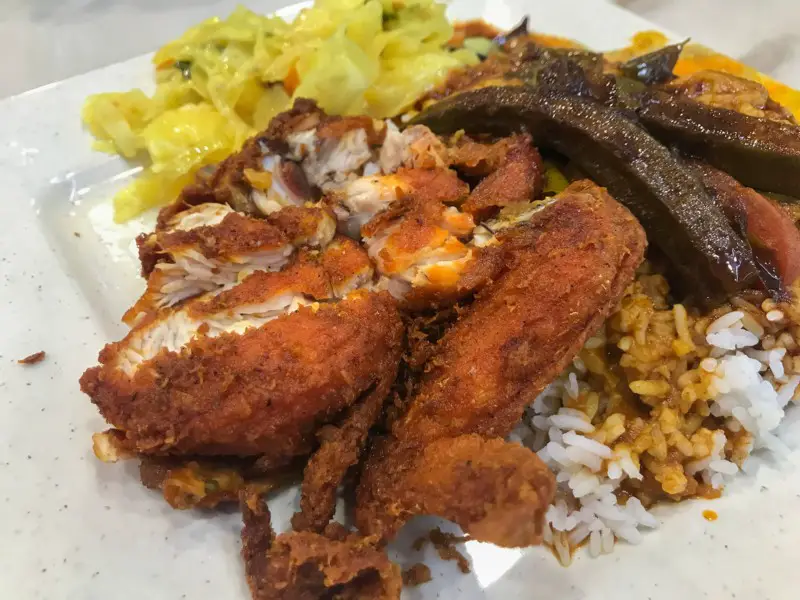
Nasi kandar is very popular in Penang thanks to all its diverse options. It’s basically a Tamil Muslim dish served with rice that has been infused with herbs and spices from a special container.
The rice is then served topped with meat and vegetables and usually a thick, spicy sauce, but often you can choose exactly what goes on top.
Options are fried chicken, beef, lamb, fried prawns as well as vegetarian dishes using items like okra and eggplant.
It’s usual to add multiple toppings and then mix it all together. It’s often served buffet style where you help yourself.
We used to eat this for lunch most days when we lived in Penang. I was vegetarian then, and I found many tasty options. Look out for nasi kandar eateries when you are in Malaysia to try this.
Nasi Biryani
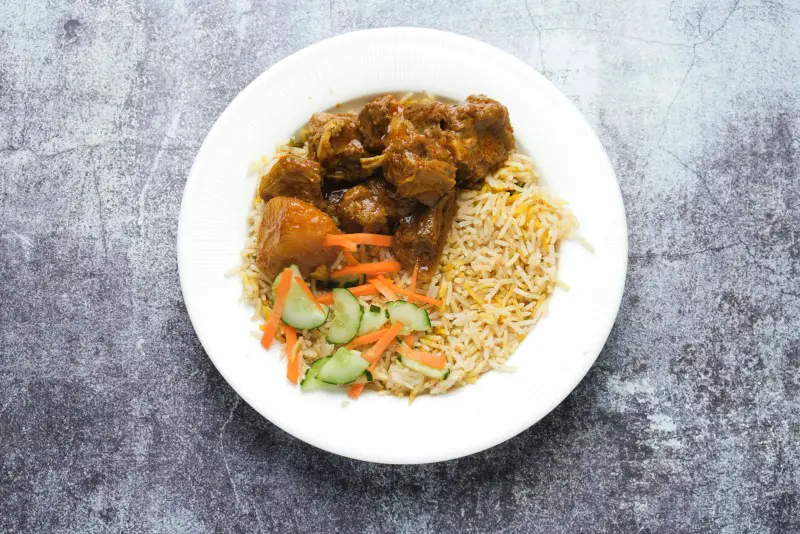
This dish travelled with Indian migrants, and Malaysia made it its own.
It’s a spicy rice dish which can be made with many different meats such as chicken, lamb, beef or prawn. Many spices are added for lots of flavour like garlic, nutmeg, cinnamon, ginger, cardamom, pepper and more.
Murtabak
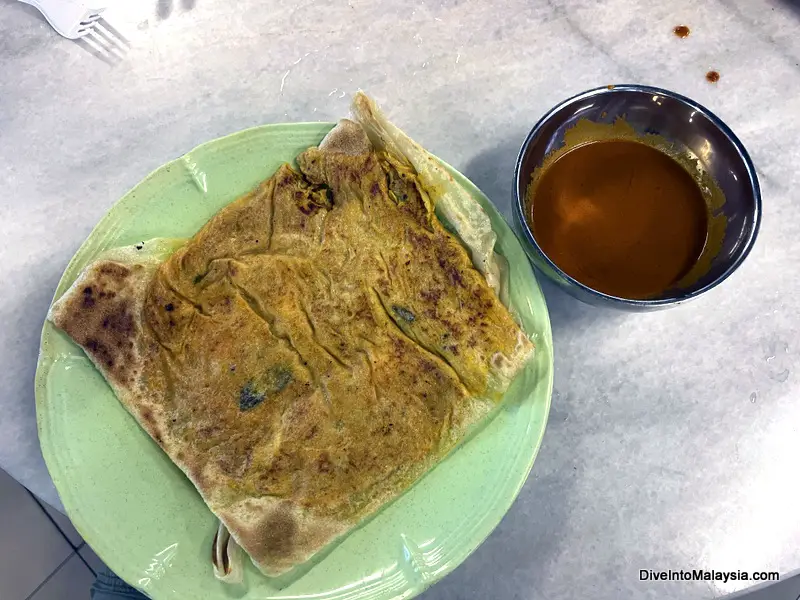
Murtabak is basically a pan-fried pancake stuffed with things like minced meat and onions with a spicy side sauce. It originates in Arabia but is a popular street food in Malaysia.
The pancake contains flour, ghee, water and oil. The stuffing is usually minced chicken or beef combined with onion, garlic and egg. It may be topped with cucumber or other garnishes.
It’s cut into squares which makes it the perfect food to eat while exploring.
Goreng Pisang

If you feel like a sweet snack, consider goreng pisang. Simply meaning fried banana, it’s made by deep frying banana pieces in a crispy batter.
The batter is made from cornstarch and cold water and coats the banana before frying. The deep frying caramelises the natural sugars in the banana to make it even sweeter than if you eat the banana raw.
It’s a great little snack that you can find in street stalls as you are exploring.
Ais Kacang/Ice Kacang

My youngest child’s favourite dessert in the world, ais kacang is the Malaysian best food for dessert or when you want to cool down and have a refreshing snack during the day. It can also be called Ais Batu Campur or ABC.
Made from shaved ice, red beans and many other items, it’s perfect for the climate. The ingredients can sound weird together, but somehow it works perfectly.
What exactly will be included varies based on the place. Common additional ingredients included condensed milk, coloured syrups, creamed corn, peanuts, ice cream and grass or fruit jellies.
The shaved ice is the main ingredient and it really hits the spot.
Depending on the place, it can look quite spectacular and Instagram-worthy.
Most Famous Malaysian Drinks
While you can find plenty of the drinks you are used to from home, there are also some famous Malaysian drinks which are worth trying while you are in Malaysia.
Teh Tarik

The Malaysian national drink, teh tarik is a sweet, hot black tea drink made with condensed milk and sometimes evaporated milk.
It translates to “pulled tea” because the drink is made by “pulling” the tea back and forth between two cups.
There’s quite an art to pulling the tea. The technique used and the distance it is pulled can affect the taste and temperature. It’s fun to watch if you get the opportunity. Try it yourself 🙂
I’m not much of a tea drinker, but the extra sweetness of teh tarik is very nice.
(Ipoh) White Coffee
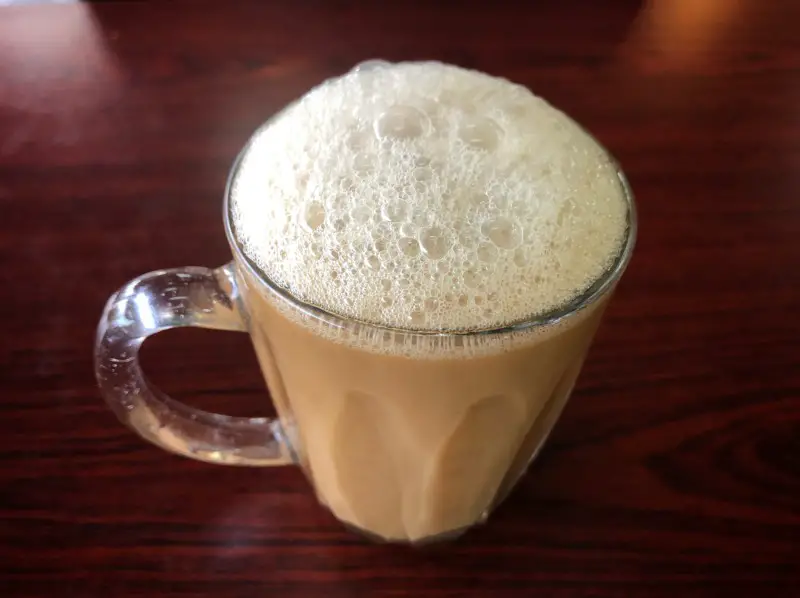
Malaysian style black coffee is made by roasting coffee beans with sugar, margarine and wheat. The difference with “white” coffee is that the coffee beans are only roasted with margarine which makes the coffee less dark.
An Ipoh white coffee is served with condensed milk. It makes the coffee more creamy and sweet.
Sirap Bandung
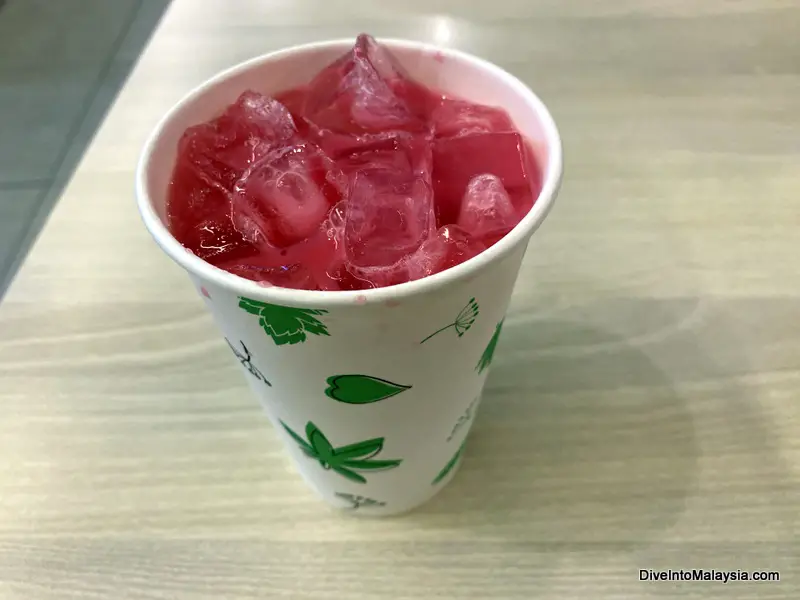
Sirap Bandung is a popular local drink made from either evaporated or condensed milk and flavoured with rose syrup. This gives it its pink colour and nice smell. It’s especially popular at Ramadan.
It’s too sweet for me, but my kids think it is the best drink ever. It’s a great reward after a day of sightseeing.
Fresh Juice

While not a Malaysian drink specifically, definitely drink some fresh juices in Malaysia.
These are not hard to find, are affordable and delicious. So a total win! It’s the perfect way to be refreshed in the heat with some vitamins as well.
Note that sugar may be added unless you ask otherwise.
How To Learn More About Food In Malaysia
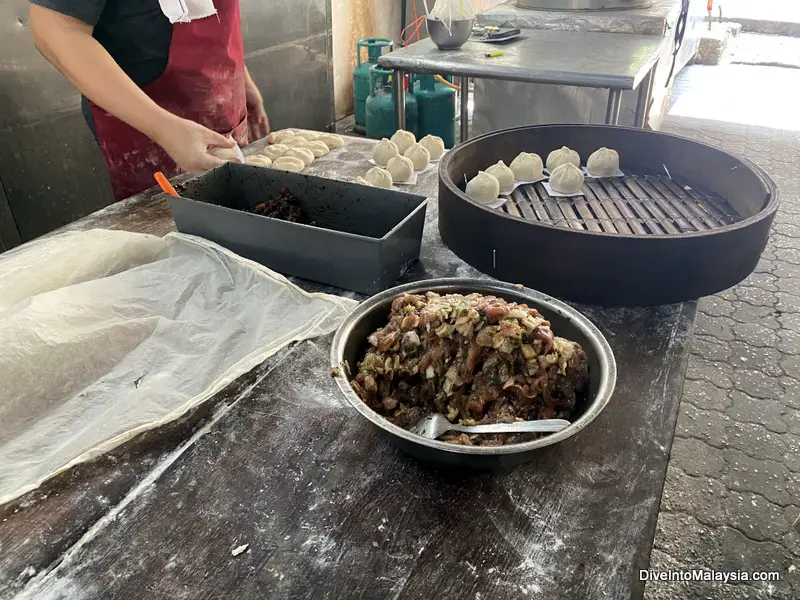
The best way to learn so much more about Malaysian food while also learning about the culture and history of Malaysia is to join a food tour.
You basically wander around a part of Kuala Lumpur or Penang while eating and drinking traditional foods with a guide who takes you to some of the attractions and helps you understand so much more about these places.
We have absolutely loved taking food tours in Malaysia. In fact, many of these photos in this article come from food tours. You can meet local vendors and taste just so much. Even if you think you already know a lot about Malaysian food, you’ll discover so much more.
And if you are new to Malaysia, this is a great way to get confidence to try new food and new places for the duration of your trip.
You can read more about your food tour options in this article OR you can sign up right now for the tour that’s best for you here. Make sure you use the discount code DIVE30 to get RM30 off your tour!
Eating In Malaysia
There are so many places to eat in Malaysia. You will definitely not struggle to find somewhere selling food, although it can be a bit overwhelming to start with. If you want to ease in to the experience, shopping centres can be a good starting point with plenty of great eating options with easy to understand menus.
Hawker Centres
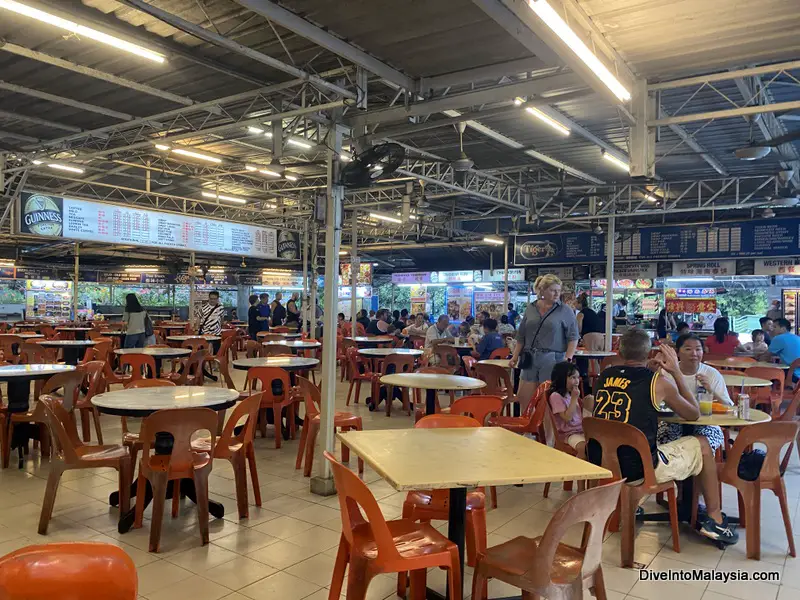
Hawker centres are my favourite places in Malaysia and where I recommend you eat if you can. These are like Malaysian food courts. They consist of many plastic chairs and tables where you can sit and eat surrounded by little food stands.
You simply order what you want from the food stands and tell them where you are sitting. They’ll bring the food over when it’s done, and you’ll usually pay at this point.
There are separate drinks stalls. Sometimes, people will roam that you can buy drinks from and sometimes, you will need to go to this stall.
It’s easy to order food from lots of different stalls making it a great way to try lots of dishes.
Other Eating Information
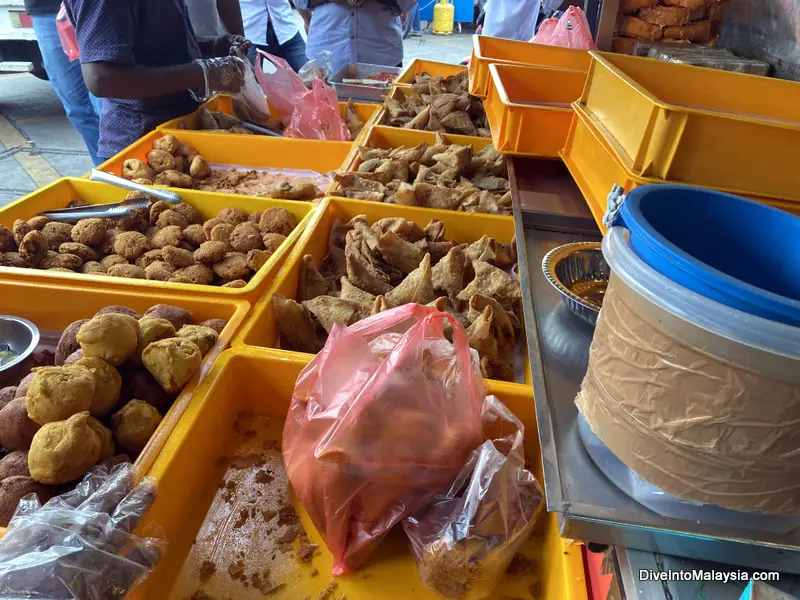
There are many other ways to access food from local restaurants to vendors running small stalls at the side of the road. You’ll find something!
There are also big supermarkets and many convenience stores.
The first time I visited Malaysia many, many years ago, I worried about how I would eat the food as I didn’t know how to use chopsticks then. However, I needn’t have worried.
The most common utensils you’ll see are dessert spoons and forks. Chopsticks are often available as well and may be the primary implement in Chinese restaurants. However, getting a fork and spoon is not a problem.
Malaysian Food Price
Food prices vary tremendously. The sky is the limit, but you can also get something for a few ringgit as well.
On our most recent trip, a standard noodle dish at a touristy hawker centre was around RM10.
Super cheap rice and noodle dishes can lack vegetables and meat and be quite plain. So pay a little more if you can for a much better taste sensation.
Final Words
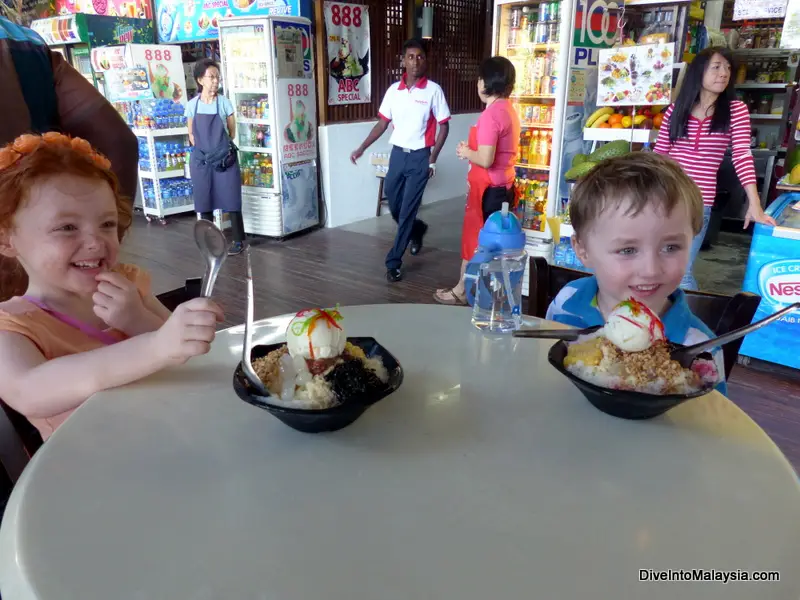
I hope you have found this guide to the best food Malaysia offers useful and it helps you try new things when you are in Malaysia.
There is so much Malaysia delicious food that eating is likely to be a highlight of your trip – as long as you step out of your comfort zone and embrace all the new things to try.
I recommend you bookmark this Malaysian food blogs on your phone so you can reference it as you travel. See how many different dishes here you can try!
Eat everything you can and have a great time!
Want to learn more about eating in Malaysia? Read our guide to taking a Kuala Lumpur food tour here and a Penang food tour here. You can also find all our guides to help you plan your trip here.
Planning a trip to Malaysia? Have any questions? Join our Malaysia Travel Planning Facebook group here now! It’s the perfect place to ask any questions and to be inspired!
